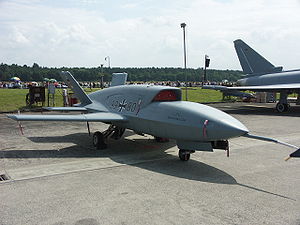Cassidian Barracuda
| Barracuda | |
|---|---|
 Barracuda in Manching |
|
| Type: | Technology demonstrator for a drone |
| Design country: | |
| Manufacturer: | |
| First flight: |
April 2, 2006 |
| Commissioning: |
In flight testing |
| Number of pieces: |
2 |
The Barracuda is a German - Spanish test and research aircraft for an unmanned military aircraft (drone) from Airbus Defense and Space .
history
The aim of the development of the Barracuda demonstrator is to gain experience with unmanned aircraft. In addition to defensive tasks such as reconnaissance and observation, the deployment of effectors should also be possible. The further development into a product was not planned, but the experiences from the Barracuda project have been incorporated into numerous new concepts from Airbus Defense and Space .
On April 2, 2006 the successful maiden flight of the Barracuda took place at the Spanish airfield San Javier in the Murcia region . The flight lasted 20 minutes and was carried out completely autonomously by the aircraft from take-off to landing. A ground control station was only used for surveillance for safety reasons.
During its second test flight on September 23, 2006, the experimental aircraft crashed into the sea shortly before San Javier Airport.
In 2008 the project was resumed and a second Barracuda was built to serve as a carrier for electro-optical sensors and to demonstrate networked operations. In July 2009 and in summer 2010 he completed a series of successful test flights at the Canadian Air Force Base Goose Bay .
development
The German-Spanish armament project was developed as an unmanned aircraft at Airbus Defense and Space in Ottobrunn, Bavaria, and in Manching ; the German Aerospace Center (DLR) in Stuttgart was involved in the development. Large parts of the structure are made of carbon fiber reinforced plastic in Augsburg.
construction
The unmanned aerial vehicle has a wingspan of around 7.22 m and a length of 8.25 m with a weight of around 3 tons. It is equipped with a Pratt & Whitney Canada jet engine with 14 kN thrust. It offers space - partly below the fuselage - for various sensors for airspace and ground surveillance.
The elevators, ailerons, rudders and flaps are operated electrically by actuators ( fly-by-wire ); the chassis is operated conventionally hydraulically. The flight control system consists of a triply redundant flight control computer, the navigation ( GPS in combination with an inertial platform ) and the processing of air and engine data . Orders are issued from the mission computer on the ground.
The drone communicates directly on sight via radio link or indirectly out of sight via satellite link.
See also
- Dassault Neuron
- BAE Taranis
- General Atomics MQ-1 Predator
- ASN-206 , ChangKong 1 u. 2 , WuZhen 5 u. 9
- Northrop Grumman / IAI RQ-5 Hunter
- IAI Heron , Northrop Grumman / AAI RQ-2 Pioneer , IAI Scout , IAI Searcher , IAI Skylite